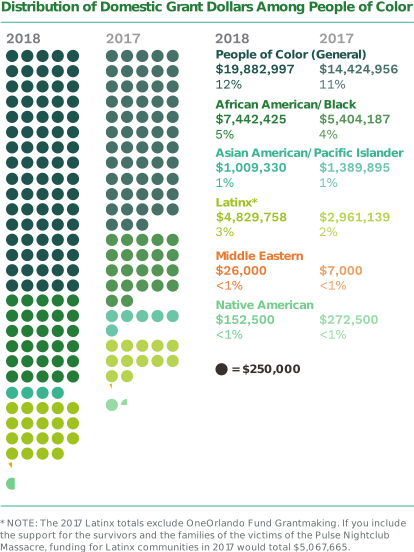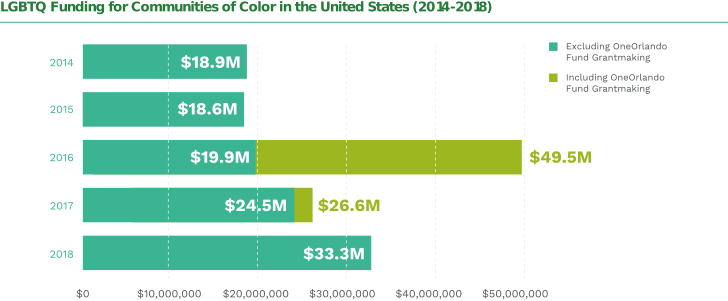Forty-two percent of LGBTQ adults identify as people of color, including 21 percent who identify as Latino/a, 12 percent as Black, two percent as Asian, and one percent as American Indian and Alaska Native. This is more diverse than the overall U.S. adult population, which is 60 percent white. The higher representation of people of color in LGBTQ communities is in part related to age. With increasing acceptance of LGBTQ people, younger generations are more likely to be out as LGBTQ. Younger people are also more likely to be of color, which is the main reason that a large proportion of people of color identify as LGBTQ. From service provision to movement building, there is a need to respond and adapt to a new generation in the U.S. that is more diverse than any previous generation in terms of race, sexual orientation, and gender identity.
At the intersection of two marginalized identities, LGBTQ people of color often face stark disparities:
-
- One in five youth in the juvenile justice system identify as LGBTQ, 85 percent of whom are people of color.
- LGBT people of color face high rates of unemployment: 15 percent of African American LGBT adults are unemployed, as are 14 percent of Latinx LGBT adults and 11 percent of API LGBT adults—compared to 8 percent unemployment for the general population.
- Gay and bisexual men of color continue to make up the majority of new HIV/AIDS infections in the U.S., with Black men accounting for 39 percent of 2014 HIV diagnoses among men who have sex with men, and Latinos accounting for 24 percent.
In recent years, a number of funders have collaborated on efforts to address the unique needs of men and boys of color. As with men and boys of color, the disparities faced by LGBTQ communities of color can be seen as a “canary in the coalmine”—an indicator of more widespread problems in a variety of systems. If funders can identify interventions that improve outcomes for the most vulnerable populations, such as LGBTQ communities of color, that will lead to system-wide change that will improve outcomes for all communities.
For more information on the unique needs and challenges faced by LGBTQ communities of color, we recommend these resources:
- The Williams Institute’s LGBTstats Demographic Data Site provides detailed data on the racial and ethnic composition of LGBTQ people and same-sex couples by state and county.
- The Movement Advancement Project provides an excellent overview of the overrepresentation of LGBTQ people of color in the criminal justice system in Unjust: How the Broken Criminal Justice System Fails LGBT People of Color.
In 2018, domestic funding for LGBTQ communities of color increased by nearly $9 million for a total of $33.3 million. An increase of $5.5 million for people of color in general, $2 million for LGBTQ black communities, and $1.9 million for LGBTQ Latinx communities led to a new record high in funding for LGBTQ communities of color, when excluding OneOrlando Fund grantmaking. Still, funding for LGBTQ AAPI communities fell by 27 percent.
Forty-five percent of the funding was awarded to advance civil rights for LGBTQ communities of color and 21 percent was awarded to address HIV/AIDS.


The top ten funders awarded $22.2 million and accounted for sixty percentof all funding for LGBTQ communities of color. Foundation for a Just Society tripled the amount it awarded to communities of color in 2018, while Gilead Sciences doubled the amount its grantmaking to communities of color.
Top Ten Funders for LGBTQ Communities of Color (2018)
| Funder Name | Amount |
|---|---|
| 1. Gilead Sciences | $5,865,298 |
| 2. Foundation for a Just Society | $3,562,500 |
| 3. Anonymous Donors (Anonymous) | $3,040,000 |
| 4. Borealis Philanthropy | $2,703,225 |
| 5. Arcus Foundation | $2,543,000 |
| 6. Astraea Lesbian Foundation for Justice | $1,141,600 |
| 7. New York Women’s Foundation | $885,500 |
| 8. Groundswell Fund | $829,309 |
| 9. AIDS United | $829,250 |
| 10. Ford Foundation | $800,000 |
| 11. Laughing Gull Foundation | $730,000 |
NOTE: Anonymous donors awarded $3,040,000 to LGBTQ commnuities of color in 2018. If included in the list above they would rank as the third largest funder.
The top ten grant recipients of funding for LGBTQ communities of color received a total of nearly $6.1 million in 2018.
Top Ten Grant Recipients of Funding for LGBTQ Communities of Color (2018)
| Organization Name | Amount |
|---|---|
| 1. Southerners On New Ground (SONG) | $2,389,450 |
| 2. Abounding Prosperity | $1,014,833 |
| 3. Third Wave Fund | $792,500 |
| 4. Planned Parenthood Federation of America | $734,766 |
| 5. Casa Ruby | $704,782 |
| 6. Funders for LGBTQ Issues | $700,000 |
| 7. Sylvia Rivera Law Project | $688,000 |
| 8. Racial Justice Action Center (RJAC) – Solutions Not Punishment (SNaP) | $682,000 |
| 9. Mijente Support Committee | $670,000 |
| 10. Hetrick-Martin Institute (HMI) | $628,400 |
For funders seeking to support work at the intersection of racial equity and LGBTQ rights, there are a number of community assets to build on:
-
- There are a number of national networks and organizations specifically advocating for LGBTQ communities of color and working to strengthen LGBTQ leaders of color around the country: the Center for Black Equity, Familia: Trans Queer Liberation Movement, the International Council of Two-Spirit Societies, the Latino Institute, the National Black Justice Coalition, and NQAPIA (the network of LGBTQ API organizations).
- At the local and regional level, many groups rooted in LGBTQ communities of color are organizing in intersectional ways to advance economic justice, immigration reform, LGBTQ justice, police reform, racial equity, and other social justice causes. Examples include Black and Pink; Southerners on New Ground (SONG); the Transgender, Gender Variant & Intersex Justice Project (TGIJP); and many of the LGBTQ youth organizing groups involved in the Get Yr Rights Network.
- Both nationally and at the state level, several LGBTQ organizations and racial justice organizations have formed coalitions or developed intersectional programs that address the unique needs and experiences of LGBTQ people of color.
- LGBTQ leaders of color are at the forefront of many social justice movements, including the movement for Black lives, the immigrant youth movement, and the trans justice movement.
- Several programs have strong track records of building the leadership of LGBTQ people of color, such as the Pipeline Project and the Brown Boi Project’s executive director training program.
Building on these assets, funders have several opportunities to advance racial equity and LGBTQ rights:
- Build capacity of groups rooted in LGBT communities of color: There are dozens of organizations doing important intersectional work rooted in LGBTQ communities of color, but most are under-resourced or highly dependent on restricted government grants for HIV and health services. Funders have an opportunity to build the capacity of these grassroots groups to build out their staffing, fundraising, advocacy, and communications.
- Support LGBTQ leaders of color: LGBTQ leaders of color are already having a visible and powerful impact in a range of movements. Funders have an opportunity to support these leaders, both through direct investment in their work and through leadership development programs.
- Support intersectional organizing and alliances for racial justice and LGBTQ rights: A growing number of organizations and coalitions are advocating for both racial justice and LGBTQ rights in integrated, intersectional ways. Funders have an opportunity to assure that these efforts are fully resourced and sustained so as to foster meaningful long-term change on issues ranging from nondiscrimination protections to policing reform.

